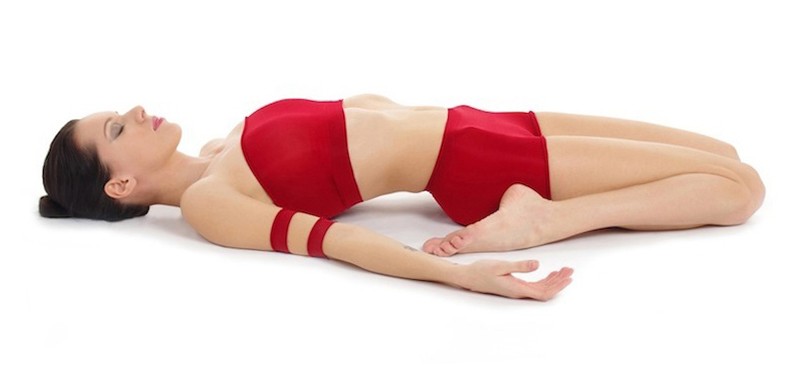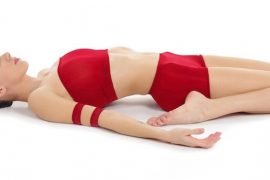Yoga postures supta virasana (reclining hero position)
Supta virasana is the horizontal version of virasana I. While virasana I is an excellent yoga posture to meditate and practice pranayamas, supta virasana can be called an excellent relaxation exercise. An exercise that offers rest to tired legs, such as standing or walking after a day.
The pelvic region and the abdominal organs also receive a thorough massage. Do not use supta virasana for back, knee and ankle complaints. This difficult variant is only suitable if you can sit effortlessly between your feet. Athletes may benefit greatly from supta virasana.
Origin of supta virasana (horizontal hero position)
The Sanskrit word supta means “lying” and vira means “warrior”, “hero” or “triumphator.” Asana is another word for ‘(sitting) posture’ and forms the third phase of the eightfold yoga path of Patanjali ( Yoga-Sutras ). In this classical yoga posture from hatha yoga , the seat rests between the feet on the floor and the upper body is completely bent backwards in phases to the floor.
It is not an exercise for beginners. Supta virasana is avoided in most yoga courses . However, if you perform this exercise in safe phases, you do not have to worry that you will suffer a back injury when you lean back.

Supta virasana (reclining hero) / Source: Kennguru , Wikimedia Commons ( CC BY-3.0 )
Technic
The problem with this asana is that many people feel that they cannot lean back ‘safely’ due to a lack of support points. Always lean on the elbows when performing this asana. If necessary, use a stack of hard cushions and so first do the ‘half’ supta virasana. This yoga posture is only suitable if you have full control of virasana I.
- Go into virasana I (hero attitude). Sit between the feet on the floor, hands on the thighs, knees together. The footrest on the rubs and point backwards.
- Hold the feet with your hands.
- Exhale and carefully lean back. Place the elbows on the floor one by one.
- Make a hollow back while leaning even further back. The back of the head now touches the floor, while you rest on the elbows and forearms.
- Now extend the arms forwards, lowering the back, which completely touches the floor along its entire length. Breathe in calmly in full yoga breathing .
- If necessary, make a circle with the arms to the back and lay them straight and parallel behind your head.
- Stay in supta virasana for a few seconds at the beginning, or as long as it feels comfortable. The better you control supta virasana, the more you can stay in this advanced yoga posture for up to five minutes.
- Return in reverse order to virasana I.
- Rest in savasana if necessary .
Points of attention
Performing the classic supta virasana, where the entire back rests on the floor, many experience as a bridge too far but also as a victory once it succeeds. It is a matter of daring and perseverance. For you as a beginner , it is important that you lean on the elbows first while leaning back and that the back of the head touches the floor afterwards. The next phase is that the shoulders rest on the floor, so that the back remains hollow before you attempt to flatten the back.
Cushions
If you find this phased version still too difficult, you can possibly lie back on a number of cushions. So leave the back and pelvic muscles gradually get used to the full supta virasana by leaving out the cushions one by one over time. First seek medical advice for back, ankle and knee problems. Supta virasana is only suitable if you have full control of virasana I (hero attitude).
Benefits
Supta virasana makes the knees and hips flexible and corrects flat feet in the long term thanks to the stretching of the feet and ankles, which benefits the foot arches. It is the ideal posture for tired legs. Moreover, this yoga posture stretches the abdominal muscles, and that indirectly improves digestion . Just like virasana I, this asana can also be practiced immediately after a meal. Runners and other athletes may benefit greatly from supta virasana. Among other things, bhujangasana (cobra posture) and baddha konasana (shoemaker posture ) are good preparatory basic postures.
Health effects of supta virasana (lying hero)
Forcing is out of the question. That also applies to all yoga postures , but for supta virasana in particular. Make progress gradually by removing the words “rush” and “performance orientation” from your yoga vocabulary.
Therapy
Supta virasana has a therapeutic and supportive, but not necessarily a healing effect on, among other things, the following complaints, ailments and disorders:
- Flat feet.
- Digestive problems.
- Constipation .
- Back pain due to fatigue .
- Varicose veins .
- Sciatica.
- Asthma.
- Insomnia.

